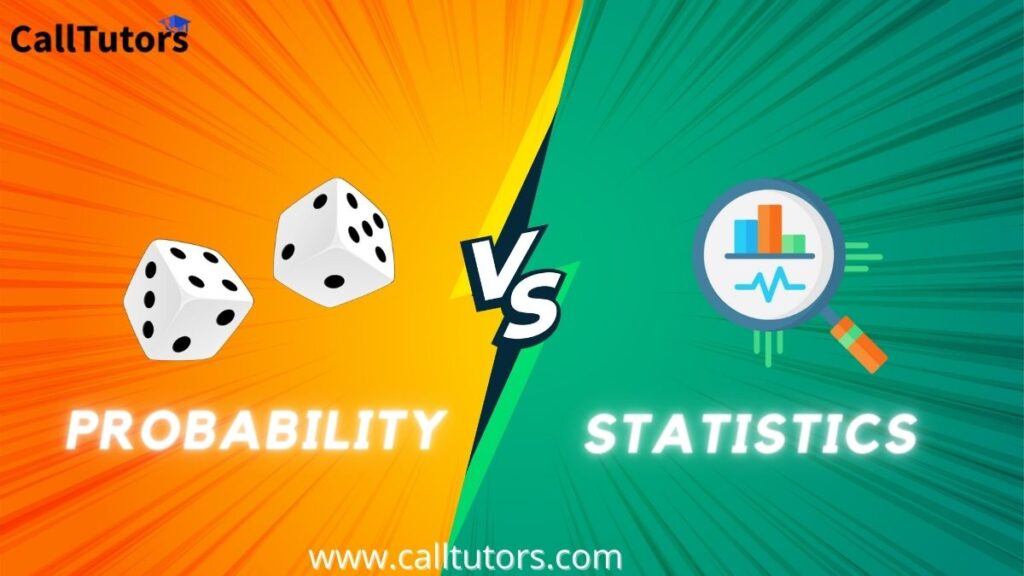Most people believe Probability vs. statistics both are parts of mathematics. But they exactly do not know what’s the difference between Probability and statistics.
Do you also understand that Probability and statistics are the same as they give us outcomes based on guesswork?
If yes, we will introduce you to the differences between Probability vs. statistics. Different concepts of Probability and statistics are used for various purposes.
So, if you are interested to know all about Probability and statistics, keep scrolling to further information. In this blog we will discuss all different aspects of probability and statistics such as definition, examples, uses etc.
Overview
Table of Contents
The foresight of a future result is known as Probability. But examining the repetition of earlier results is statistics, and Statistics is a branch of applied mathematics, while Probability is a theoretical branch of mathematics.
Yet, as an arithmetic understudy, you should realize that they are not the equivalent. There can be a ton of representations between them, and however, they are as yet unique about one another.
Mathematical reasons for the connection you can learn from understanding the difference between them. The idea behind the unsuccessful mathematicians and students is that they couldn’t distinguish between Probability and statistics.
Probability Vs. Statistics- The differences
Definition
Definition of Probability
The outcome is noticed in this phenomenon, which happens during the result and explains the whole event. In Probability, we can take some possible results to determine the event or outcome. Probability always lies between 0 to 1.
Where 0 represents impossibility, and one represents certainty. The higher the quantity of likelihood near one, the more possibilities that the event will occur. The probability of universal truth always remains one, such as the probability of the sun rising from the east is 1.
Definition of Statistics
Statistics is the study of the collection, analysis, interpretation of data with different mathematical concepts. Experimental data are shown by using the quantified models and figures in statistics. There are a lot of methods to get the review, analyze, examine, and get conclusions from the data gathered.
It is the data that is summarized during the analyst to identify the set of data. Statistics are used to collect and evaluate data analysis, and it also can be applied to represent the data in numerical form.
Example of Probability vs. statistics
Example Of Probability
Dice is an excellent example of Probability that has six sides, and mathematicians predict the dice to land. Each face has an equal chance, which is ⅙. For example we throw a dice once, what is the probability of coming 3. It will be 3/6 or ½. |
Example Of Statistics
In statistics, we can use dice in different situations with another opinion. For this, we will monitor how often each number comes and for that, the statisticians need to observe the object for a while. It concludes that the perceptions are contrary to the suspicion of equivalent likelihood faces. Here decisions are taken on the consistency of the observation and assumptions. |
Types Of Probability vs. Statistics
Probability
The main types of Probability are the following:
Classic Probability
It is the first type of Probability. It is related to dice and coins. In this way, we can estimate the reading of the most probable results of the actions. E.g., the coin. There will always be two chances, either head or tail. On the other hand, if you throw the coin 20 times, then there will be a total of 40 outcomes. The number of possible outcomes depends on the number of throws of coins or dice.
Experimental Probability
It depends on the no. of probable outcomes by the total no. of actions.
E.g., In a coin, if we toss it 100 times and 40 times, we get the head, then the general Probability is 40/100.
Theoretical Probability: In the theoretical probability we use the possible probability of the likely outcomes of an event will occur. For example if we have dice and we want to know the theoretical probability of getting 5, as the total cases are 6 because a dice has 6 sides. Then the theoretical probability of coming 5, will be 1/6, that means you have one chance of getting 5 out of 6.
Subjective Probability: It is based on a person’s opinion and judgments,and also known as personal probability. It is the probability of an individual’s assumptions. For example, you watched a movie, so your decision about the movie’s performance depends on your mood or perception and your expectations. On the basis of your situation, you can decide the movie was good or bad.
Types Of Statistics
Statistics has two types.
Descriptive Statistics
Descriptive statistics tell us about the common characteristics of data, or we can say it describes the basic data features after the collection of data. Here the statisticians analyze the data quantitatively. Here we simply show what data is about and what it reflects.
Types Of Descriptive Statistics
- Central tendency measures
- Variability measures
Inferential Statistics
The intricate part of the statistics is inferential statistics. Complicated mathematics calculations take place in inferential statistics, and these estimates are helpful in predictions. With the help of inferential statistics, we try to reach a conclusion. Here we use inferentiality to determine what the population thinks.
Types of inferential statistics
- Correlation analysis
- Analysis of covariance (ANCOVA)
- Regression analysis
- Analysis of variance (ANOVA)
- Statistical significance (t-test)
Common Careers in Statistics vs. Probability
Applications Of Probability vs. Statistics
Applications of Probability
Probability in Maths
Probability is an important concept of mathematics that relates to the numerical illustration of an occurring event. Probability theory is widely used in the study areas such as finance, statistics, machine learning, game theory and philosophy.
Weather Planning
Probability concepts help meteorologists to predict the weather for a specific day and country. They gather the database of weather forecasts all over the world to note down temperature changes.
Sports
Probability theories assist us in determining the strength and weaknesses of a team or player. In sports, coaches use concepts to evaluate the team’s performance in different areas.
Insurance
Probability theory is very useful for insurance companies because it enables them to frame the policies. It helps them to predict the possibility of future outcomes.
Applications of Statistics
Statistics in disease prediction
Statistics plays an important role in the medical field, and it enables us to know how many people are impacted by the disease. Here we can take the current situation of covid-19. According to the studies, approximately 80 percent of the world has been affected by the COVID-19 virus. All these measurements are done with the help of statistics.
Statistics in Sports
Many applications of statistics are there in sports. Different sports such as tennis, cricket, volleyball, and others use statistics for various purposes. Statistics help to improve the effectiveness of a sport, and a sportsperson can understand his or her performance in a specific sport. Different types of tools are used to collect data for various reasons.
Statistics in Corporate Sectors
The success of any business depends on recognizing what is significant or what is not essential. Business entities use statistics theories or methodologies to predict or analyze the current and future growth of enterprises.
Conclusion
To conclude, probability and statistics are two different terms used for various reasons in almost all fields. There are various applications or both and play a vital role in different operations.
In this blog, we have discussed probability vs. statistics and their examples, along with applications. I hope now you are clear about the concepts of probability and statistics and found this blog necessary.
If you are a statistics student and need the help of a statistics homework helper, we are here to help you. Get the best statistics help for students from experts at nominal rates.
FAQs
What is the primary difference between probability and statistics?
Statistics is an applied branch of mathematics, while probability is the theoretical branch of math. Other than that, probability works on predictions of the likelihood of future events, while statistics deals with the analysis of the frequency of past events.
What are the terminologies of Probability vs. statistics?
Terms used in probability are-
Experiment
sample space
Event
Terms commonly used in statistics-
Population
Sample




